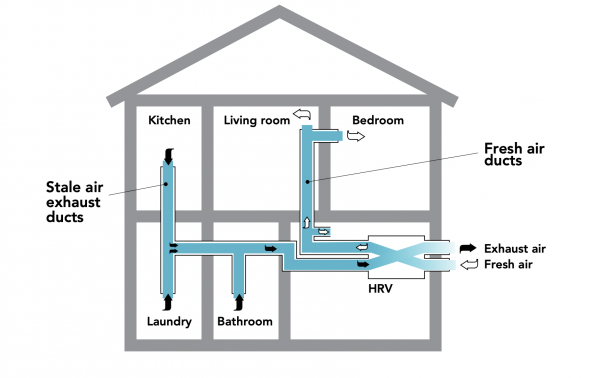As new building codes standards lead to tighter building envelopes, homes are requiring mechanical ventilation solutions to keep the indoor air fresh.
The simple answer to the headline of this article is anyone (human or animal) living and working indoors. The larger question is how we go about providing enough fresh oxygenated air for building inhabitants while maintaining reduced levels of HVAC energy consumption as prescribed by current governmental regulations.
What Kind of Air?
With today’s tighter building envelopes we need to consider how to introduce air inside and why. And we might need several kinds of air. Normally there’s only one type of air, but inside a building we need the air to do different things depending on our indoor activities.
Ventilation air is the most important kind for humans and animals. Humans respire some 30 lbs. of air daily while we spend almost 90% of our lives indoors. At the same time, it is necessary to get rid of excess moisture, odours, carbon dioxide, ozone, particulates and other noxious compounds. And while opening a window provides needed ventilation air, this unregulated ventilation will cause HVAC systems to consume excessive amounts of energy—energy we’re supposed to be saving.
Mechanical Ventilation
Modern houses and commercial buildings pay much greater attention to air and moisture leaking either into or out of the building, and with standards such as LEED, Passive House and Net Zero, houses are tight and the building envelope is sealed with an air leakage goal of no more than 1ACH50 (one air change per hour at 50 pascals). I’ve seen one Passive House consultant boast of 0.14ACH50.
And today’s HVAC systems are better designed with gas furnaces and water heaters using outdoor air for combustion, so life is good, no? Maybe not so good, as we are still seeing rules of thumb making the rounds especially in renovation jobs where ventilation systems are often oversized, and powerful range hoods can still suck nearly every molecule of air out of the house forcing would-be chefs to open a window.
Introducing HRV and ERV
A heat recovery ventilator (HRV) is a mechanical ventilation solution that will use the stale exhaust air stream to preheat the same volume of cold entering outdoor fresh air.
As the air streams pass each other within the core of the HRV, upwards of 75% or better of the indoor air heat will be transferred to the colder air thus providing needed ventilation while reducing the cost of “making up” the heat required to bring that fresh air up to ambient room temperature.
In humid geographies, in the summer months an HRV will increase the humidity level in the house. With a cooling unit in operation and the windows closed, the house still needs adequate ventilation. A properly sized cooling system designed with the summer latent load in mind should be able to deal with the extra humidity, admittedly, at an extra cost.
An ERV, or energy recovery ventilator, operates in a similar fashion to the HRV, but during the winter some of the humidity in the air is returned to the indoor space. Ideally, in tighter houses, an ERV will help to retain indoor humidity in the 40% range countering the uncomfortable and unhealthful effects of dry wintertime air.
Summer operation has the ERV reject as much as 70% of the incoming humidity sending it back outside before it can load-up the cooling system. An ERV does not act as a dehumidifier.
ERV’s Are Better for a Humid Climate
Installation Considerations
While ERV/HRV units designed for residential installation can be installed in a simplified fashion using the existing air handling system to distribute the conditioned air, do not do it that way if possible.
In my opinion, it is best to install a fully dedicated duct system in new construction or complete renovation jobs. The building will benefit from the best possible conditioned air distribution and the lowest possible operating cost, as the furnace or air handler fan will not be needed. Here is an Example of an HRV installation with direct duct work. (source: NRCan Publication (2012): Heat Recovery Ventilators)

To get more information please visit: https://www.hpacmag.com/features/ventilation-who-needs-it/














